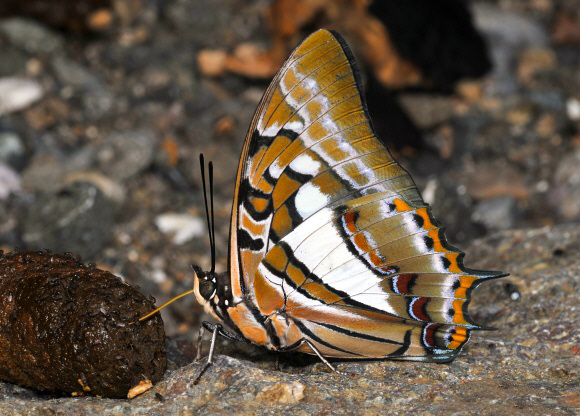
Introduction
There are 24 species in the genus Polyura, most of which are found in the Oriental region, although one species posidonius is restricted to Tibet and west China; 6 or 7 are endemic to various islands, e.g. andrewsi from Christmas Island and caphontis from Fiji; and one, pyrrhus reaches Queensland in Australia.
The butterflies are characterised by their distinctive wing shape with twin tails on the hindwings, a feature strongly reminiscent of the African Charaxes. Most have dark brown uppersides with bands of dazzling creamy white which vary in size and shape from one species to another. These bands are repeated on the underside, usually in a beautiful shade of pale green. In a few species such as delphis the underside is almost entirely white.
Polyura jupiter is found in West Irian, the Bismark archipelago, Bougainville, the Admiralty islands and probably elsewhere in the Papuan region.
Habitats
This species inhabits rainforest at elevations between sea level and about 500m.
Lifecycle
I have no data regarding jupiter, but the lifecycle is likely to be very similar to that of other Polyura species: The eggs are spherical, shiny and usually yellow. They are laid on the underside of leaves of the foodplants. The larvae when fully grown are green, and frequently have prominent diagonal stripes. They have large heads adorned with a crown of 4 long horns. They feed nocturnally on the foliage of various trees and shrubs e.g. Albizia, Acacia, Abarema, Adenanthera, Peltophorum and Leucaena ( Fabaceae ), Grewia ( Malvaceae ) and Caesalpinia ( Caesalpinaceae ). The chrysalis is green, and has a plump, rounded and compressed abdomen. It is attached by a stout pedunculate cremaster to a twig or stem on or near the foodplant.
Adult behaviour
Males are strongly attracted to carnivore faeces. Once feeding they are very reluctant to leave their meal. If forcibly ejected they fly very rapidly up into nearby trees, but invariably return within a few minutes. It is not uncommon to find 3 or 4 Polyura males of mixed species crowding over fresh dung.
